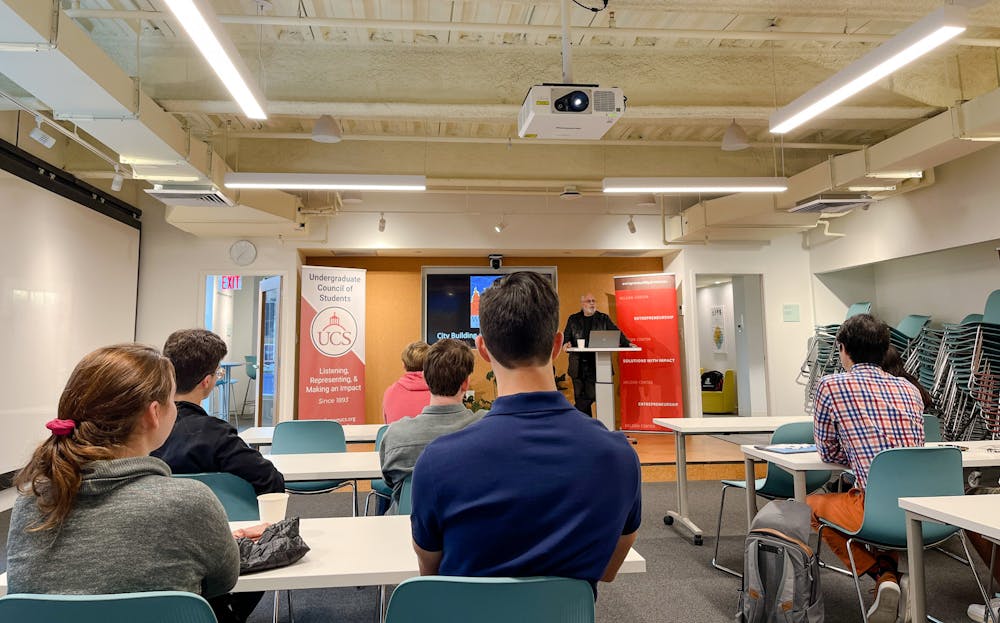It seems hard to imagine Providence without the river that runs through its core — or to imagine that same river without WaterFire.
Created by Barnaby Evans ’75 almost 30 years ago, WaterFire has brought crowds of people from all different backgrounds to Providence’s riverfront, with families, couples and friends all gathering together under the dim cover of firelight. For each lighting, the team at WaterFire builds all parts of the display from scratch and takes it all away by dawn the next day.
WaterFire is more than just a community event in Providence, Evans said at a talk co-hosted by the Undergraduate Council of Students and the Brown Entrepreneurship Program Friday. Built to bolster the city’s tourism and entrepreneurship, the tradition now generates millions of dollars for the city and attracts visitors from across the country, he added, noting that cities around the globe have adopted their own versions of the event.
This practice of building and rebuilding is core to the event, inspired by the more than 1,000-year-old wooden Ise Grand Shrine in Japan, which is rebuilt every 20 years, according to Evans. WaterFire’s focus on reconstruction aims to underscore how the craft of building can maintain and strengthen a community.
“Can a city be entirely re-invented?”
In recent decades, Providence’s downtown has transformed dramatically. Fifty years ago, “Providence was in trouble,” Evans said. “There was nothing going on, there weren’t even restaurants downtown (that) would open in the summer.”
But Providence has always been an “extremely entrepreneurial city” with a “pretty remarkable history to hear,” Evans said, pointing to its early uptake of automobile manufacturing.
In recent years, local stakeholders have worked to improve public conditions. The Providence River Park, for example, was a work of public entrepreneurship that placed “a bet on the future of the city,” Evans said. Decades prior, community members with similar hopes of transforming Providence — specifically, a group of local designers — wanted to uncover the river that went underneath the streets of Providence, according to Evans. “The only way we (could) do that … (was) to physically pick up the river,” he said.
According to Evans, the river relocation project included relocating the Woonasquatucket River, the Moshassuck River and their confluence with the Providence River.
“The only reason why the designers wanted to move the river … was they felt it really important that the park not be stopped by buildings (so people did not have) to go around (or) through traffic and come back to the park,” he said.
Construction for the project led the downtown World War I Monument to be moved to a new site, making way for three separate bridges along the riverfront, two of which disguised pipe carriers.
Reflecting on the project, Evans noted that many businesses and enterprises struggle to make their ideas connect with the public. Taking into consideration how city residents would engage with the newly-uncovered riverfront, Evans began to envision WaterFire as a way to bring the river park positive attention.
The team wanted to “make Providence a destination city and a place where things happen to the streets downtown,” Evans said.
“Building as a verb”
The artistic intention behind WaterFire comes from a Shinto temple in Japan — Ise Jingu — which, constructed approximately 1,300 to 2,000 years ago, is one of the world’s oldest preserved wooden objects, according to Evans. “Every 20 years, they build the temple again,” he said.
Evans emphasized that the tradition the temple creates is significant to WaterFire and the community it sustains.
“Their reverence is for the building, but not the building as a noun, but the building as a verb,” he said.
“Shinto tradition says that it’s not the physical object that has its presence and its importance to the community,” Evans said. “It's the fact that the community is engaged with entrepreneurship and energy to communitize the building, and that the skills to build it are still held within the living community.” Similarly, WaterFire brings people together under themes of reconstruction, community and entrepreneurship, he added.
Evans said that the WaterFire display is built from scratch for each lighting because the event’s organizers want to foster a sense of community among volunteers, reflecting on the process as a collective ritual maintained and passed down within the community.
When the fire is first ignited, it burns brightly then grows darker and darker until a boat “comes over the horizon, out of the darkness,” full of volunteers and members of the community to add their own block of wood to bring the fire back, Evans said. Similar to how “entrepreneurs would add their ideas” to the community, “that’s how a community keeps itself on track,” he added.
According to Evans, WaterFire represents all stages of life in a community. People have marriage proposals, celebrate weddings and host funerals during WaterFire — but event organizers never publicly announce them. “It (is) up for people to figure out” what they’re witnessing, he said.
Evans added that he tried “to build a work that would use elements of many, many cultures.”
“If you think of the fire references, you’ll see that echoes respectfully from cultures all over the planet,” he said. I want “to talk about what it is that we as humans gather together (in this) ritual celebration.”
According to Evans, WaterFire is “a very meditative, almost religious work about the fragility of life.” Evans added that WaterFire represents “a balance between life and death.”
“If you think of fire as representing life, it's always, miraculously and dangerously, right above the water that (could) instantly put it out,” he said. “But you can reverse that in the end game as well, because fire will boil water away to nothing.”
WaterFire also incorporates other binaries, like hot and cold and dark and light. “If you start to think about them, (you) will see them throughout the piece,” he said.
Evans also noted that organizers purposely choose background music that the public might not be familiar with — including music from different cultures.
“If you’re listening to music, you sort of put it in the background, (and) you already have an emotional state that’s associated with that,” he said. “Your brain is doing something different when it has to respond to music it doesn’t know.”
“We’re creating WaterFire deliberately to have various elements out there,” Evans added. “When you next go to WaterFire … just sit down next to a stranger and say, ‘What is this thing?’ You just started a conversation. He’ll talk to you for hours.”
A counterintuitive entrepreneur piece
The first WaterFire was held on Dec. 31, 1994, under a snowfall that welcomed the start of a new year, according to Evans. He added that they only intended to have the event once, but many attendees asked him after the inaugural lighting when the next event would be.
Today, Evans noted that WaterFire is held about 20 times a year. “This year, I think we’re doing (it) 24 times over nine months,” he said.
Evans listed six rules for hosting WaterFire: build the entire thing from scratch in a single day; turn off all the surrounding lights; set everything on fire; do the exact same event every night; never advertise at all and invite everyone to come for free; and break it all down by dawn.
“It's a very counterintuitive piece (of) entrepreneurship, particularly doing it for free,” he added.
Evans said that the yearly WaterFire budget is $2.4 million, which covers costs associated with portable bathrooms, performers, boat maintenance and a team of roughly 20 full-time, paid staff — although WaterFire relies largely on a group of volunteers, which ranges from 50 to 300 people on a given day.
According to Evans, WaterFire primarily functions financially through sponsorships. Companies sponsor an event by collaborating on its programming. For example, the University will sponsor an Oct. 22 lighting to celebrate Family Weekend, covering roughly half of the lighting’s total cost.
The other half of the event’s funding, Evans said, comes from the state. WaterFire “generates about $150 million in spending every year” for Rhode Island from the sales and hotel taxes paid by people who dined and stayed in Providence for the event, he said.
WaterFire also collaborates with nonprofit organizations on projects, Evans added. Recent efforts have included raising awareness for clean water, collaborating on projects with the Narragansett Indian Tribe and working with the Gloria Gemma Breast Cancer Awareness Institute to help breast cancer survivors celebrate life with their families and thank their clinicians.
WaterFire, according to Evans, has turned Providence into a destination city. Cities such as Rome, Venice, Singapore and Houston have hosted their own WaterFire events modeled after the Providence original.
When Evans first created WaterFire 28 years ago, he did not imagine it to become a city tradition. He simply wanted to bring community members together, immersed in the same ritual and spiritual atmosphere. He feels he’s succeeded.

Kathy Wang was the senior editor of community of The Brown Daily Herald's 134th Editorial Board. She previously covered student government and international student life as a University News editor. When she's not at The Herald, you can find her watching cooking videos or writing creative nonfiction.





